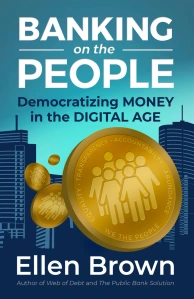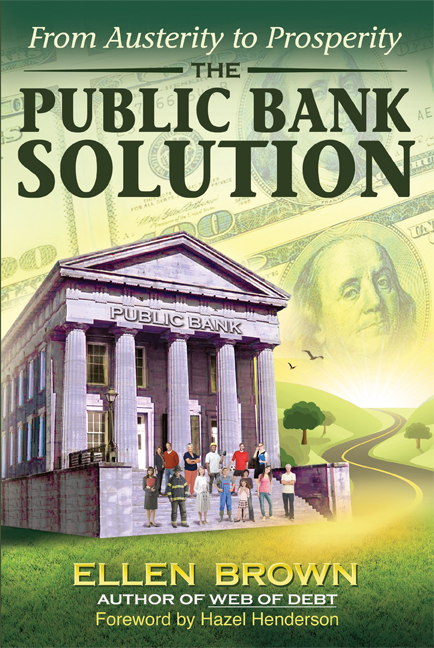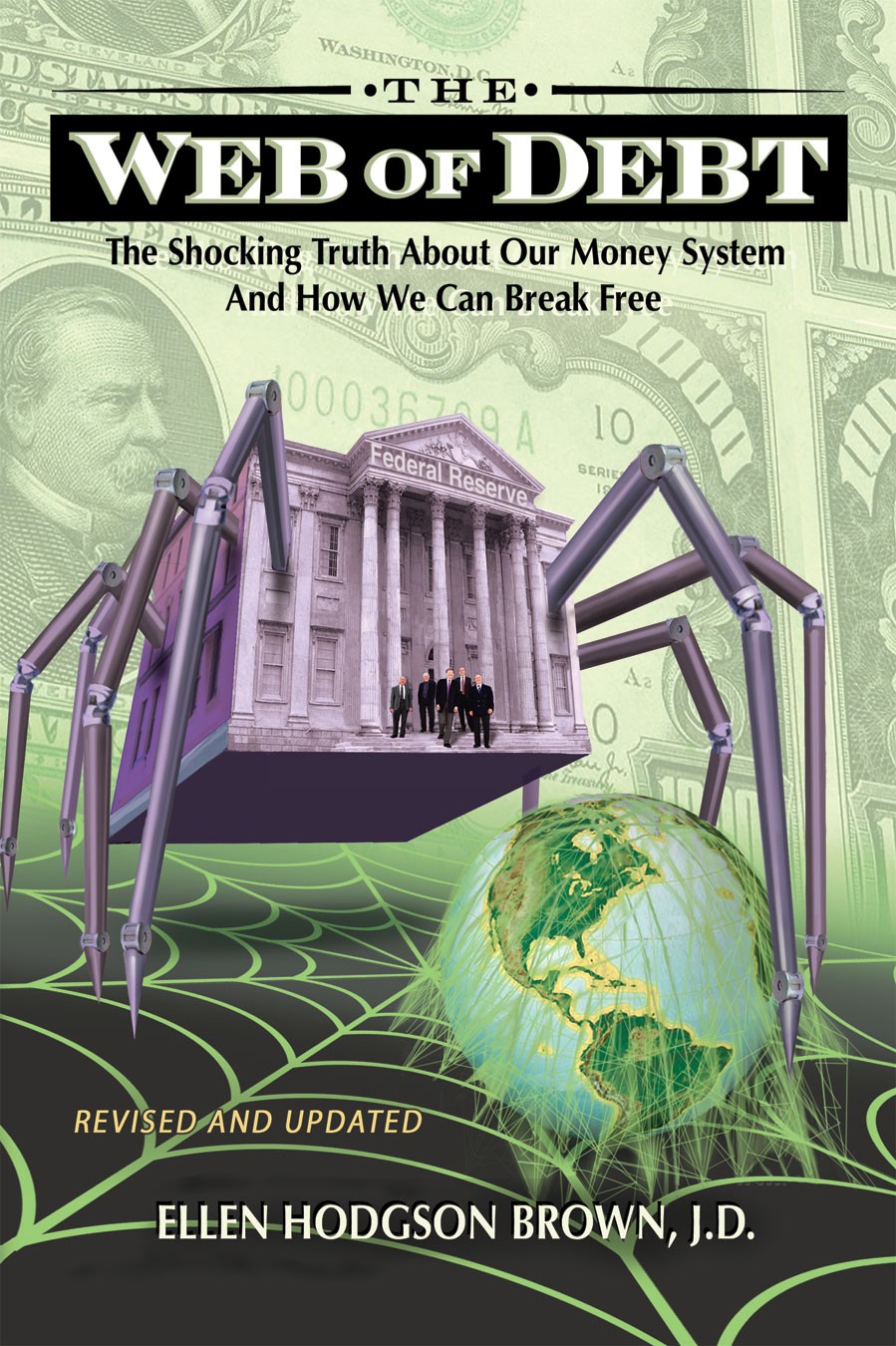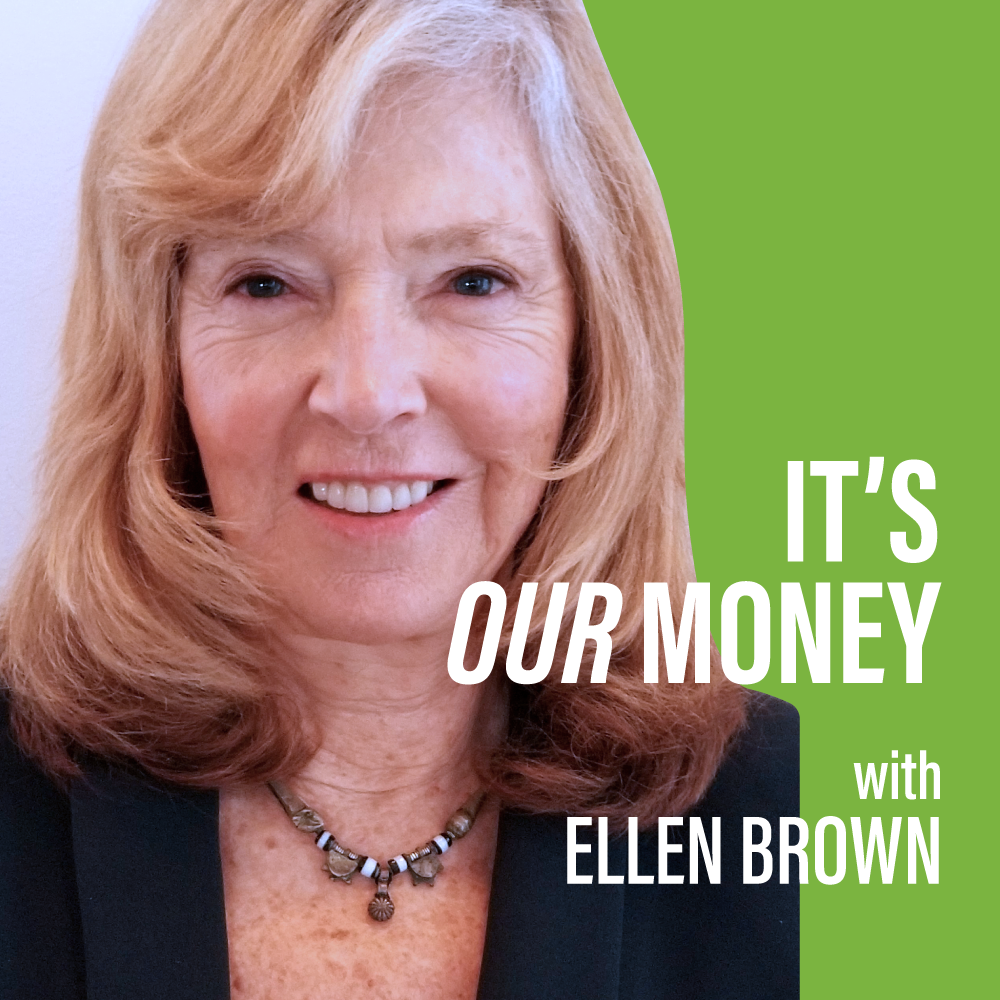Debate continues to rage between the inflationists who say the money supply is increasing, dangerously devaluing the currency, and the deflationists who say we need more money in the economy to stimulate productivity. The debate is not just an academic one, since the Fed’s monetary policy turns on it and so does Congressional budget policy.
Inflation fears have been fueled ever since 2009, when the Fed began its policy of “quantitative easing” (effectively “money printing”). The inflationists point to commodity prices that have shot up. The deflationists, in turn, point to the housing market, which has collapsed and taken prices down with it. Prices of consumer products other than food and fuel are also down. Wages have remained stagnant, so higher food and gas prices mean people have less money to spend on consumer goods. The bubble in commodities, say the deflationists, has been triggered by the fear of inflation. Commodities are considered a safe haven, attracting a flood of “hot money” — investment money racing from one hot investment to another.
To resolve this debate, we need the actual money supply figures. Unfortunately, the Fed quit reporting M3, the largest measure of the money supply, in 2006.
Fortunately, figures are still available for the individual components of M3. Here is a graphthat is worth a thousand words. It comes from ShadowStats.com (Shadow Government Statistics or SGS) and is reconstructed from the available data on those components. The red line is growth in the M3 money supply as reported by the Fed until 2006. The blue line is the growth in M3 after 2006.
The chart shows that the overall U.S. money supply is shrinking, despite the Fed’s determination to inflate it with quantitative easing. Like Japan, which has been doing quantitative easing (QE) for a decade, the U.S. is still fighting deflation.
Here is another telling chart – the M1 Money Multiplier from the Federal Reserve Bank of St. Louis:
Barry Ritholtz comments, “All that heavy breathing about the flood of liquidity that was going to pour into the system. Hyper-inflation! Except not so much, apparently.” He quotes David Rosenberg: “Fully 100% of both QEs by the Fed merely was new money printing that ended up sitting idly on commercial bank balance sheets. Money velocity and money multiplier are stagnant at best.” If QE1 and QE2 are sitting in bank reserve accounts, they’re not driving up the price of gold, silver, oil and food; and they’re not being multiplied into loans, which are still contracting.
The part of M3 that collapsed in 2008 was the “shadow banking system,” including money market funds and repos. This is the non-bank system in which large institutional investors that have substantially more to deposit than $250,000 (the FDIC insurance limit) park their money overnight. Economist Gary Gorton explains:
[T]he financial crisis . . . [was] due to a banking panic in which institutional investors and firms refused to renew sale and repurchase agreements (repo) – short‐term, collateralized, agreements that the Fed rightly used to count as money. Collateral for repo was, to a large extent, securitized bonds. Firms were forced to sell assets as a result of the banking panic, reducing bond prices and creating losses. There is nothing mysterious or irrational about the panic. There were genuine fears about the locations of subprime risk concentrations among counterparties. This banking system (the “shadow” or “parallel” banking system) ‐‐ repo based on securitization ‐‐ is a genuine banking system, as large as the traditional, regulated banking system. It is of critical importance to the economy because it is the funding basis for the traditional banking system. Without it, traditional banks will not lend, and credit, which is essential for job creation, will not be created. [Emphasis added.]
Before the banking crisis, the shadow banking system composed about half the money supply; and it still hasn’t been restored. Without the shadow banking system to fund bank loans, banks will not lend; and without credit, there is insufficient money to fund businesses, buy products, or pay salaries or taxes. Neither raising taxes nor slashing services will fix the problem. It needs to be addressed at its source, which means getting more credit (or debt) flowing in the local economy.
When private debt falls off, public debt must increase to fill the void. Public debt is not the same as household debt, which debtors must pay off or face bankruptcy. The U.S. federal debt has not been paid off since 1835. Indeed, it has grown continuously since then, and the economy has grown and flourished along with it.
As explained in an earlier article, the public debt is the people’s money. The government pays for goods and services by writing a check on the national bank account. Whether this payment is called a “bond” or a “dollar,” it is simply a debit against the credit of the nation. As Thomas Edison said in the 1920s:
If our nation can issue a dollar bond, it can issue a dollar bill. The element that makes the bond good, makes the bill good, also. The difference between the bond and the bill is the bond lets money brokers collect twice the amount of the bond and an additional 20%, whereas the currency pays nobody but those who contribute directly in some useful way. . . . It is absurd to say our country can issue $30 million in bonds and not $30 million in currency. Both are promises to pay, but one promise fattens the usurers and the other helps the people.
That is true, but Congress no longer seems to have the option of issuing dollars, a privilege it has delegated to the Federal Reserve. Congress can, however, issue debt, which as Edison says amounts to the same thing. A bond can be cashed in quickly at face value. A bond is money, just as a dollar is.
An accumulating public debt owed to the IMF or to foreign banks is to be avoided, but compounding interest charges can be eliminated by financing state and federal deficits through state- and federally-owned banks. Since the government would own the bank, the debt would effectively be interest-free. More important, it would be free of the demands of private creditors, including austerity measures and privatization of public assets.
Far from inflation being the problem, the money supply has shrunk and we are in a deflationary bind. The money supply needs to be pumped back up to generate jobs and productivity; and in the system we have today, that is done by issuing bonds, or debt.
————
Ellen Brown is an attorney and president of the Public Banking Institute, http://PublicBankingInstitute.org. In Web of Debt, her latest of eleven books, she shows how a private cartel has usurped the power to create money from the people themselves, and how we the people can get it back. Her websites are http://webofdebt.com and http://ellenbrown.com.
Filed under: Ellen Brown Articles/Commentary |








Ellen, you’ve changed your tune. Money is not debt. Do you know something Aristotle didn’t? You must address the fact that money is a claim on future energy use. You need to address HR 6550, the NEED Act.
Money is a generalized form of debt. Owning a dollar bill means that somebody owes you a dollar’s worth of something, at a time and manner of your choosing more or less.
Well said!
I disagree.
The US$ and FIAT money is a generalised form of debt. Actually Fiat currency is not actually ‘money’, it is a debt-claim.
Owning a gold coin means that… you own the gold coin. Period.
There is no debt associated with it. No future claim against someone. No one ‘owes’ you any ‘backing’ to that claim.
Contrast that with a Federal Reserve Note, or even a GLD ETF. Both are claims.
Incidentally, that was written by Invictus (See the byline to the piece you referenced)
Good article, Ellen.
Now, can we change the system so we don’t have to issue debt with interest owed to the private financiers?
I hate to be the wet blanket here, but a government controlled by corporate and right wing idealogues (including the President) has no intention of pursuing monetary policy that benefits ordinary working people in any fashion.
The far right wing of the Beltway uniparty ran last fall on the platform of “jobs, jobs, jobs”. Now that they are in office, they are rampaging against unions, women’s reproductive rights and publicly held anything. The center right wing of the Beltway uniparty publicly wrings their hands and proclaims that there is nothing they can do, while privately making deals that harm working people.
Many of our fellow Americans feel sad, angry, resigned and powerless in the face of the corruption, lies and plunder of our national resources. I believe that Americans have become a broken people. An article by Bruce E. Levine describes how we got to this point and how to move past it: http://www.alternet.org/story/144529/are_americans_a_broken_people_why_we%27ve_stopped_fighting_back_against_the_forces_of_oppression/?page=entire.
I am generally heartened and inspired by the positive and cleareyed tone of the articles of this blog. However, expecting corporate controlled politicos to listen to and empathize with the working folk of this country is a naive notion.
I could use a big dose of positive morale. And some help giving it, along with knowledge and understanding, to everyone I meet. Then perhaps we can actually do something to improve this world.
True. It’s 3 am and I’m feeling a bit powerless myself. That gold/silver drop killed me. They can do whatever they want with the markets and we just have to take it. We’re discovering more and more what they’re up to, and they don’t really care; they own the Congress, own the laws, own the corporations. That was the plan, and they’re nearly there. I do think that if we could slip a state-owned bank or two in there though, we could demonstrate another model.
It certainly does feel as though our federal government has sold us out for commercial interests. Corporations are self-serving entities and banks are fleecing the public of their livelihoods.
I hold out some hope for smaller units of government (state and local) although the political climate in my state isn’t looking so good at the moment either.
Individually, we can still tap our freedoms to help ourselves. My views on personal finance have changed completely since the housing crisis. Bankruptcy and foreclosure used to have a strong social stigma attached. Now I look at neighbors stuck in upside-down mortgages, scraping by to make minimum monthly payments, and wonder: Why haven’t they done something about it yet? If the banks have no shame in charging us usurious rates, we should have no shame in fighting back. (And I could go on a similar tirade about the oil companies, but will save that for another day.)
Prior to the recession, I had trust and confidence in our banking system. That’s all but gone now. I’ve shed my personal debt and it’ll be a cold day in hell before I borrow another dime from a commercial banking institution. And all we really had to give up was our extravagant lifestyle. My family doesn’t have much now, but we are happier and living relatively stress-free.
Meanwhile, I watch credit card companies, mortgage lenders and banks ramp up advertising as people go back to work in preparation for another round of fleecing. And they will have customers, which amazes me.
If elections have become meaningless, folks, vote with the only thing that counts these days: your dollar.
The whole problem with going debt free is that only a few can do so without reverting to a lifestyle of poverty. Every paid off debt is that much less money in the system, making it harder and harder for everyone to get the money they need to buy food, clothes, or pay for housing and transportation.
Only by changing the system so that money and debt are no longer intrinsically linked, can everyone go debt free.
Because the American dollar is the reserve currency the effective devaluation caused by quantitative easing is causing inflation in other countries even if the USA is still experiencing deflation
But it isn’t being devalued by quantitative easing. “Devalued” means there is more money chasing fewer goods, and that’s not true; we’re not even up to where we were in 2008, money supply-wise. The culprits, to my mind, are such things as high-frequency program trading, commodities manipulation, and an extremely low interest rate causing a dollar carry trade.
The new dollars that US creates do not stay in US alone. They are going all around the world – specifically to BRIC nations. US is exporting its inflation to other countries.
You write: “Congress no longer seems to have the option of issuing dollars, a privilege it has delegated to the Federal Reserve.”
Congress can order the printing of U.S. notes (versus selling bonds for Fed notes) in a trice. It did so within days of default in the Civil War. All that Congress need do is change the words “Federal Reserve” to “United States” in its printers, and print!
Despite rumours to the contrary, there remain greenbacks from the Civil War, in circulation. Kennedy last reissued some of them as two-dollar bills–I received and spent one just last week! (They cost $10 on e-Bay).
I have a Civil War first-issue myself, with which I could buy something for a dollar. However, I paid $777.77 for it on e-Bay–it’s the bill featured in my video at
In the early 90s, I believe an act was passed prohibiting the executive from any further replenishing of the Civil War issuance.
Of course, after Lincoln’s death, the banks adopted a strict policy of never recirculating US notes. They want us to forget all about them-including how trivial it would be to produce and circulate them.
What then is the real reason for commodity price increase? What would be the effect if margin reqirements were raised, would this not stop the increase? Why don’t they want to do this? If all the $ is being used for speculation, stop that by increasing margin requirements. Won’t that help?
Ellen, the Gary Gorton paper you referenced explains how commercial lenders became unprofitable without the shadow banking system. He writes:
“At root this change has to do with the traditional banking system becoming unprofitable in the 1980s. During that decade, traditional banks lost market share to money market mutual funds (which replaced demand deposits) and junk bonds (which took market share from lending), to name the two most important changes. Keeping passive cash flows on the balance sheet from loans, when the credit decision was already made, became unprofitable. This led to securitization, which is the process by which such cash flows are sold.”
What I’m curious about is how this might affect public banking, in which there won’t be shareholders to demand profits. Would a public banking system have been immune to the Panic of 2007? If so, what would be the source of their funding?
That Gary Gorton stuff is really illuminating. Securitization is what kept the shadow banking system going, and that’s where the banks got the money they borrowed to cover the loans they had already made. A public bank wouldn’t need to borrow its deposits. The BND has outstanding loans equal to its deposits. The state itself has a massive revenue stream and potential deposit base. If it just moved that money into its own bank, it would be home free.
I would be interested what Ellen Browns view is on the bill,
http://www.govtrack.us/congress/billtext.xpd?bill=h111-6550
There is a similar proposal being worked on in the UK.
http://positivemoney.org.uk
Seems to me both proposals are constructive reform of the requisite banking systems and the basis for a fair money system (by the end of fractional reserve banking).
I wish the U.S. Congress and president would sign that bill into law, as written, right now!
I wrote a response but didn’t post it. The general idea is good, but the way it’s drafted, it won’t work. They want the banks to borrow a sum equal to all their outstanding loans from the central money-issuing body. The problem is, the banks have already borrowed every penny they’ve lent; that’s the way our check-clearing system works. If they have to borrow it again, they’ll go bankrupt. You might say fine, let them; but they control Congress, so it’s not going to happen.
Are you sure you read it correctly? The bill purports to replace all bills with paper or digital currency. Nobody (not even the banks) goes into a significant amount of bad debt here as fractional reserve banking becomes illegal.
The only group who can now create more money from thin air is the equivalent of the fed, but they are no longer a private entity and must report to congress (while acting politically independently).
The fed are now printing dollers not bonds. It’s not a punitive measure to destroy banks who are put in the role of what they often purport to do in the current system, the sensible distribution of real capital (with real risk).
I might have missed a detail in the transition measures of course. Certainly more actual money will need to be created during a transitional period because as Ellen’s article suggests there is a scarcity of capital at the present state in the US economy.
Maybe a subject for another article rather than a comment.
It is depressing to hear the word ‘THEY’ popping up as the pronoun for our dictators. You say ‘THEY’ want allow themselves to go bankrupt. I agree with you but it means that there is nothing we can do unless ‘THEY’ decide on the answer.
How can we achieve anything without the approval of ‘THEY’? Abe Lincoln opposed ‘THEY’. He was killed. Kennedy was trying to regulate ‘THEY’. He was killed. Eliot Spitzer, who was trying to blow the whistle on the ‘THEY’ and was disgraced. Dominique Strauss-Hahn(head of the IMF) is in the process of being disgraced by I wonder? If a leader comes out of this blog or your think tank (Public Banking Institute) with a healthy push to nationalize the Feds gets close to achieving a public bank for our nation or even a couple of States, don’t you think he or she will disappear in a black hole?
It seems, this whole idea of change is just an intellectual discussion. ‘THEY’ will always have the money and, as someone put it, the “raw power” to do as ‘THEY’ will since ‘THEY’ have the power to issue our money supply.
I’ve read, agreed with, passed your book around and told lots of people about it. I’ve been very enthused at the prospect that you or someone would rise out of this discussion like a beacon of truth. But first of all and before there is even the worry of ‘THEY’ retaliation, the ordinary worker is going to have to be educated and convinced that you have answer. It has to be the ‘THEY’ against he voters. As you know the ordinary worker don’t pay attention to this subject because they are brain washed into thinking it is over their heads and should be left to the experts — that, ‘THEY’ are the experts. This discussion becomes very difficult to follow for people that have to make a living. It’s a quagmire.
The real question seems to me is how do you fight a tyranny of this kind? ‘THEY’ don’t obey the laws but they make the laws. Maybe the answer is in a new kind of revolution which is gathering a whirlwind of attention. Have you been paying attention to Julius Assange – alias ‘Anonymous’ on Wikileaks. With all the research you’ve done it seems to me that you could provide sources of leaks that might be as good as or better than the one Assange is holding about Bank-of-America which is yet to be leaked! Just a thought.
I am a fan and that isn’t likely to change
tp
As Ron Paul is repeating ad-infinitum this kind of stimulus is the foundation for the next bubble, and his plan is to move back to the gold standard (which many think is equally bad) also doing away with the money multiplier of fractional reserve banking.
Nobody knows where the next bubble is forming but I believe that Ron Paul is correct that there will be a gigantic one coming. Banks are not malicious (in my opinion, at least on aggregate) but they are un-democratic, private institutions and have self interest at heart. If Goldman Sachs was not starving people in the third world with commodity trading then some other organisation would be doing it in their place.
The problem is systematic risk, in this case a risk which rating agencies have absolutely no hope of identifying. You can’t regulate enough against this. In any economy a bubble will form of some size, but when it bursts the effect needs to be isolated from the rest of the system. Let financial regulation identify isolated bad lending decisions not systematic risk because they just can’t do the latter.
The systematic risk is because money goes around in the current system so many times as it is credited out against again and again. When one set of credit goes bad, then credit dries up in many areas at once.
The M3 money supply statistic includes components that are not used as money to actually purchase goods. The real money supply is actually currency in circulation, demand deposits and savings accounts (because you can make 6 withdrawals per month and because overnight and on weekends some demand deposits get reclassified as savings deposits to help reduce reserve requirements). If you calculate the growth of these components it’s over 10% on a year over year percentage basis.
A big component of M3 is CDs which are not used to purchase goods on demand. The total value of CDs reflect the transfer of purchasing power from a saver to a borrower. Low interest rates would of course contribute to a decline in the volume of funds invested in CDs. But when interest rates are higher, the volume of funds invested into CDs grows. So with rising interest rates, the amount of funds invested in CDs would show an increase helping to grow M3 money supply metric but the real money supply figures like currency and demand deposits dollar amounts could be shrinking thus leading to an eventual credit crunch. People looking at M3 would wonder why there would be a credit crunch when M3 is growing by double digits? which would be due to the shrinking or declining growth of the real money supply components.
“Prices of consumer products other than food and fuel are also down” WTF? You obviously haven’t been doing your own food shopping !